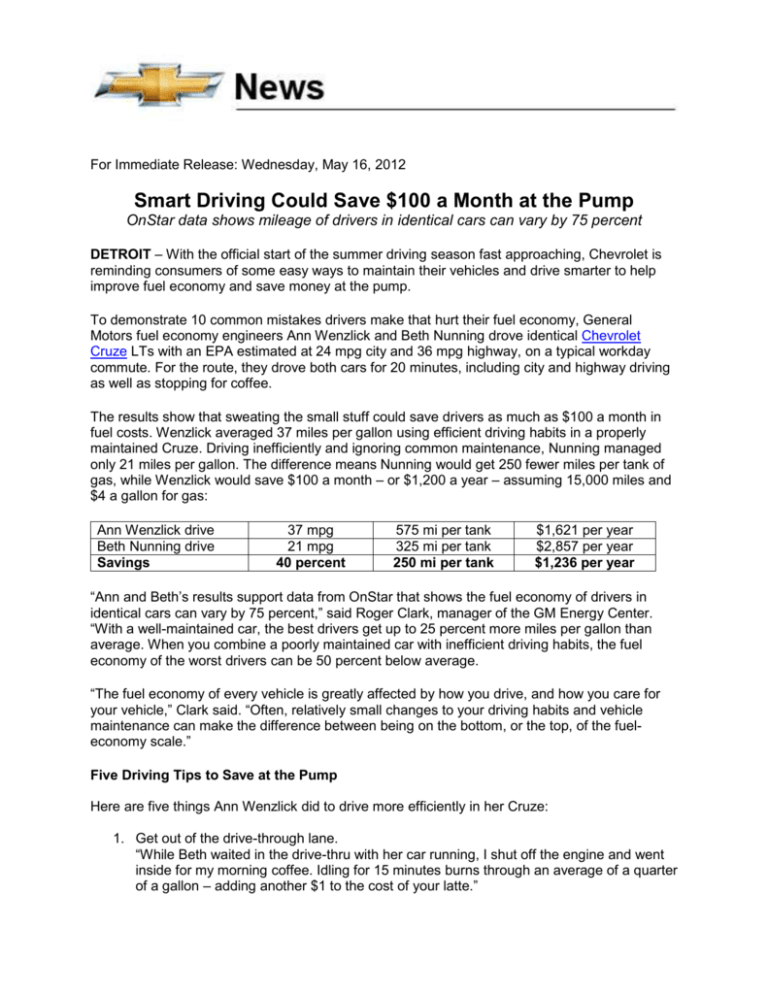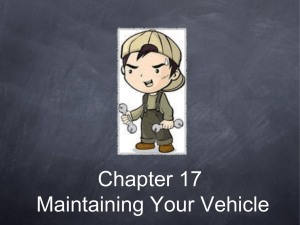Word - GM Media - General Motors
advertisement

For Immediate Release: Wednesday, May 16, 2012 Smart Driving Could Save $100 a Month at the Pump OnStar data shows mileage of drivers in identical cars can vary by 75 percent DETROIT – With the official start of the summer driving season fast approaching, Chevrolet is reminding consumers of some easy ways to maintain their vehicles and drive smarter to help improve fuel economy and save money at the pump. To demonstrate 10 common mistakes drivers make that hurt their fuel economy, General Motors fuel economy engineers Ann Wenzlick and Beth Nunning drove identical Chevrolet Cruze LTs with an EPA estimated at 24 mpg city and 36 mpg highway, on a typical workday commute. For the route, they drove both cars for 20 minutes, including city and highway driving as well as stopping for coffee. The results show that sweating the small stuff could save drivers as much as $100 a month in fuel costs. Wenzlick averaged 37 miles per gallon using efficient driving habits in a properly maintained Cruze. Driving inefficiently and ignoring common maintenance, Nunning managed only 21 miles per gallon. The difference means Nunning would get 250 fewer miles per tank of gas, while Wenzlick would save $100 a month – or $1,200 a year – assuming 15,000 miles and $4 a gallon for gas: Ann Wenzlick drive Beth Nunning drive Savings 37 mpg 21 mpg 40 percent 575 mi per tank 325 mi per tank 250 mi per tank $1,621 per year $2,857 per year $1,236 per year “Ann and Beth’s results support data from OnStar that shows the fuel economy of drivers in identical cars can vary by 75 percent,” said Roger Clark, manager of the GM Energy Center. “With a well-maintained car, the best drivers get up to 25 percent more miles per gallon than average. When you combine a poorly maintained car with inefficient driving habits, the fuel economy of the worst drivers can be 50 percent below average. “The fuel economy of every vehicle is greatly affected by how you drive, and how you care for your vehicle,” Clark said. “Often, relatively small changes to your driving habits and vehicle maintenance can make the difference between being on the bottom, or the top, of the fueleconomy scale.” Five Driving Tips to Save at the Pump Here are five things Ann Wenzlick did to drive more efficiently in her Cruze: 1. Get out of the drive-through lane. “While Beth waited in the drive-thru with her car running, I shut off the engine and went inside for my morning coffee. Idling for 15 minutes burns through an average of a quarter of a gallon – adding another $1 to the cost of your latte.” 2. Take it easy “In the city, I accelerated smoothly while Beth demonstrated one of the most common mistakes we see on the road: Jumping on the gas at every light, only to hit the brakes as she caught up with the traffic ahead. Such aggressive driving isn’t going to get you home any faster, while driving smoothly can improve your mileage by 20 percent.” 3. Driving 70, not 80. “On the highway, I drove 70, compared to Beth’s 80. Again, a 10-mph difference likely won’t add much time to your daily commute, but it will save you up to four miles per gallon on the highway.” 4. Use cruise control “I tried to maintain a constant speed during our drive, while Beth’s fluctuated with traffic. Try using cruise control when possible, and maintaining a constant speed over time, which is much more efficient than speeding up and slowing down over and over again.” 5. Roll up the windows “One of the most common questions we get is ‘Is it better to drive with the A/C on, or off?’ At slower speeds, turning off the air conditioning can save you a little, but I always roll up the windows on the highway. Beth was driving with her windows down, and the increased air pressure acted like a parachute trying to slow her down – consuming much more energy than air conditioning ever will.” Five Vehicle Mistakes That Hurt MPG: Here are things that contributed to Beth Nunning’s poor fuel economy: 1. Low tire pressure “All four tires on my car were five pounds under their recommended air pressure. That’s not enough to change how the Cruze drives, but it does make the engine work much harder to turn the wheels. Check your tires at least once a month, as a tire that is 10 pounds under pressure can cut your fuel efficiency by more than 3 percent.” 2. Using roof ornaments “To show support for my Detroit Tigers, I put up window flags on my Cruze for every home game. But, when the boys hit the road, the flags will come down. At highway speeds, up to a third of your fuel is used to overcome wind resistance, so even small changes to your vehicle’s aerodynamics will have a big impact in fuel economy.” 3. Carrying extra junk in the trunk “I had six bags of water-softener salt in the trunk I bought on sale at the hardware store. But, according to EPA estimates, every 100 pounds of weight can reduce fuel economy by 2 percent. While I saved at the checkout, that 240 pounds of salt added almost 5 percent to my fuel costs for the trip.” 4. Ignoring the “check engine” light “I called OnStar to run a remote diagnostics check on my Cruze, because the check engine light was on. Turns out the light was on because the gas cap was loose. But more serious engine problems can cut your fuel economy by up to 40 percent.” 5. Not bundling errands “An engine at operating temperature is up to 50 percent more efficient than a cold engine. So, when possible, it’s much better to run five errands in an afternoon, than running one errand every day of the week. Regular Vehicle Maintenance Tips That Can Save Money in the Long-run: 1. Make your tires last Properly inflated tires will improve your fuel economy, and they will last longer. Also rotate tires at manufacturer-recommended intervals. 2. Use the recommended grade of motor oil Motor oil that says “Energy Conserving” on the performance symbol of the American Petroleum Institute contains friction-reducing additives that can improve fuel economy. 3. Check your owner's manual for the most effective octane level for your car. For most cars, the recommended gasoline is regular octane. In most cases, using a higher-than-recommended octane gas offers no benefit – and costs more. 4. Batteries can make or break you Check battery life, replace or charge your current battery and make sure battery cables are free of corrosion. Many breakdowns occur because batteries aren't delivering full cranking power. 5. Get regular engine tune-ups and car maintenance checks. According to the EPA, tune-ups improve performance as well as gas mileage. Check your owner’s manual for recommended maintenance schedules and follow them. This will avoid fuel economy problems due to worn spark plugs, dragging brakes, low transmission fluid, or the transmission failing to go into high gear. 6. Be skeptical about any gizmo that promises to improve your gas mileage. The EPA has tested supposed gas-saving devices – including “mixture enhancers” and fuel line magnets – and found that very few provided any fuel economy benefits. The devices that did work provided only a slight improvement in gas mileage. In fact, some products may damage your car’s engine or cause a substantial increase in exhaust emissions. For a full list of tested products, visit www.epa.gov/otaq/consumer/reports.htm. Founded in 1911 in Detroit, Chevrolet is now one of the world's largest car brands, doing business in more than 140 countries and selling more than 4million cars and trucks a year. Chevrolet provides customers with fuel-efficient vehicles that feature spirited performance, expressive design, and high quality. More information on Chevrolet models can be found at www.chevrolet.com. ###






